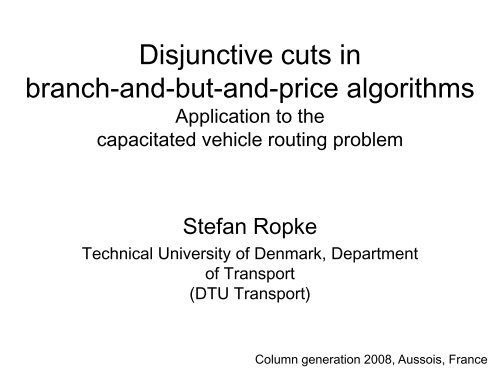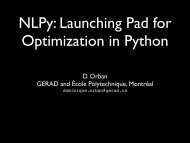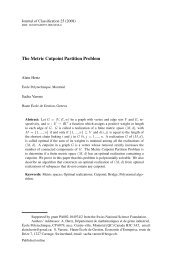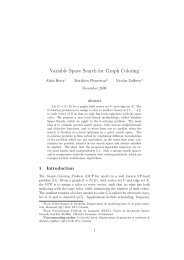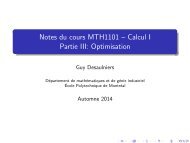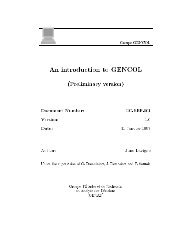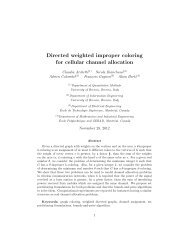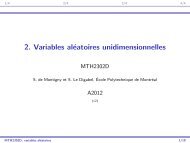Disjunctive cuts in branch-and-but-and-price algorithms ... - gerad
Disjunctive cuts in branch-and-but-and-price algorithms ... - gerad
Disjunctive cuts in branch-and-but-and-price algorithms ... - gerad
Create successful ePaper yourself
Turn your PDF publications into a flip-book with our unique Google optimized e-Paper software.
<strong>Disjunctive</strong> <strong>cuts</strong> <strong>in</strong><br />
<strong>branch</strong>-<strong>and</strong>-<strong>but</strong>-<strong>and</strong>-<strong>price</strong> <strong>algorithms</strong><br />
Application to the<br />
capacitated vehicle rout<strong>in</strong>g problem<br />
Stefan Ropke<br />
Technical University of Denmark, Department<br />
of Transport<br />
(DTU Transport)<br />
Column generation 2008, Aussois, France
<strong>Disjunctive</strong> <strong>cuts</strong> <strong>in</strong><br />
<strong>branch</strong>-<strong>and</strong>-<strong>but</strong>-<strong>and</strong>-<strong>price</strong> <strong>algorithms</strong><br />
Application to the<br />
capacitated vehicle rout<strong>in</strong>g problem<br />
Stefan Ropke<br />
Technical University of Denmark, Department<br />
of Transport<br />
(DTU Transport)<br />
Column generation 2008, Aussois, France
Motivation<br />
• Our goal: Solve difficult IP problems.<br />
• Our approach: Branch-<strong>and</strong>-<strong>price</strong> (BAP).<br />
• A major reason for us<strong>in</strong>g BAP: reduced<br />
gap between LP bound <strong>and</strong> optimal<br />
solution (<strong>in</strong>tegrality-gap).
Motivation<br />
• Initially (Eigthies <strong>and</strong> first half of the<br />
n<strong>in</strong>eties): Happy with improved IP-gap<br />
from Dantzig-Wolfe decomposition.<br />
• ”Recently” (last half of the n<strong>in</strong>eties till now)<br />
Increased research activity focussed on<br />
decreas<strong>in</strong>g the <strong>in</strong>tegrality-gap by<br />
comb<strong>in</strong><strong>in</strong>g <strong>branch</strong>-<strong>and</strong>-<strong>price</strong> with cutt<strong>in</strong>g<br />
planes (Branch-<strong>and</strong>-cut-<strong>and</strong>-<strong>price</strong> (BCP)).
Motivation: Branch-cut-<strong>and</strong>-<strong>price</strong><br />
• Ma<strong>in</strong> research trend:<br />
– Problem specific <strong>cuts</strong> <strong>in</strong> the variables of the compact<br />
formulation.<br />
• Many succesful applications:<br />
– Vehicle rout<strong>in</strong>g problem with time w<strong>in</strong>dows: Kohl, Desrosiers,<br />
Madsen, Solomon , Soumis (1999)<br />
– Multicommodity flow problems: Barnhart, Hane, Vance (2000)<br />
– Capacitated vehicle rout<strong>in</strong>g problem: Fukasawa, Longo, Lysgaard,<br />
Poggi de Aragão, Reis, Uchoa, Werneck (2006)<br />
– Multiple depot vehicle schedul<strong>in</strong>g: Hadjar, Marcotte, Soumis<br />
(2006)<br />
– Capacitated m<strong>in</strong>imum spann<strong>in</strong>g tree: Uchoa, Fukasawa,<br />
Lysgaard, Pessoa, Poggi de Aragão, Andrade (2007).<br />
• Some research on generic <strong>cuts</strong> on the variables of the<br />
extended formulation:<br />
– Petersen, Pis<strong>in</strong>ger, Spoorendonk (2007)
How about generic <strong>cuts</strong> on the<br />
variables of the compact formulation<br />
• We have a pretty good idea about such<br />
<strong>cuts</strong> should be h<strong>and</strong>eled <strong>in</strong> a BAP<br />
algorithm (well studied <strong>in</strong> the literature).<br />
• Wouldn’t it be nice if we could ”flip a<br />
switch” <strong>and</strong> our <strong>in</strong>tegrality gap is<br />
decreased by 30 or 40%<br />
• ... at the cost of more rows <strong>in</strong> the master<br />
problem <strong>and</strong> <strong>in</strong>creased separation time
Our c<strong>and</strong>idate: <strong>Disjunctive</strong> <strong>cuts</strong> <strong>in</strong> the<br />
variables of the compact formulation<br />
• Dates back to a technical report by E.<br />
Balas from 1974.<br />
• Was shown to be useful <strong>in</strong> practice by<br />
Balas, Ceria, Cornuéjols (1993).<br />
• Includes or is equivalent to a number of<br />
other generic cutt<strong>in</strong>g planes: Lift-<strong>and</strong>project<br />
<strong>cuts</strong>, split <strong>cuts</strong>, <strong>in</strong>tersection <strong>cuts</strong>,<br />
gomory mixed <strong>in</strong>teger <strong>cuts</strong><br />
• Is <strong>in</strong>cluded <strong>in</strong> some form <strong>in</strong> both CPLEX<br />
<strong>and</strong> Xpress-MP.
Our IP problem<br />
(compact formulation)
Our IP problem<br />
(compact formulation)
Our IP problem<br />
(compact formulation)<br />
Here We only consider<br />
disjunctions with two<br />
terms of the stated form<br />
(split <strong>cuts</strong>)
Our IP problem<br />
(compact formulation)
<strong>Disjunctive</strong> <strong>cuts</strong>
Objective<br />
x 2<br />
x 1<br />
1 2 3 4 5 6 7
Objective<br />
x 2<br />
x 1<br />
1 2 3 4 5 6 7
Objective<br />
x 2<br />
x 1<br />
1 2 3 4 5 6 7
Separation algorithm
Separation algorithm
The capacitated vehicle rout<strong>in</strong>g<br />
problem (CVRP)<br />
Customer<br />
Depot
Compact formulation
Solv<strong>in</strong>g the CVRP - <strong>cuts</strong><br />
• Cuts – all from Lysgaard, Letchford &<br />
Eglese (2004):<br />
– Capacity, framed capacity, strengthened<br />
comb, 2 edges hypotour, homogeneous<br />
multistar<br />
• A new family of <strong>in</strong>equalities:<br />
– subtour-depot
<strong>Disjunctive</strong> <strong>cuts</strong> for the CVRP<br />
• Step 1: all ”normal <strong>cuts</strong>” are separated.<br />
Repeat as long as violated <strong>cuts</strong> are<br />
identified.<br />
• Step 2: Construct cut-f<strong>in</strong>d<strong>in</strong>g LP based on<br />
compact formulation <strong>and</strong> already identified<br />
<strong>cuts</strong>. Solve.<br />
• Step 3: Optional: Improve cut-f<strong>in</strong>d<strong>in</strong>g LP<br />
by column generation. Generate columns<br />
from capacity <strong>in</strong>equalities.
<strong>Disjunctive</strong> <strong>cuts</strong> for the CVRP
Solv<strong>in</strong>g the CVRP - Pric<strong>in</strong>g<br />
• Shortest paths with 2-cycle elim<strong>in</strong>ation<br />
– Exact: Bidirectional label sett<strong>in</strong>g<br />
– Heuristic: Truncated label sett<strong>in</strong>g<br />
– Heuristic: Construction heuristic<br />
• Elementary shortest path<br />
– Exact: simple <strong>branch</strong> & cut (Jepsen, Petersen,<br />
Spoorendonk, 2008)<br />
– Heuristic: Truncated label sett<strong>in</strong>g<br />
– Heuristic: Construction heuristic<br />
– Heuristic: LNS
Solv<strong>in</strong>g the CVRP - details<br />
• Branch<strong>in</strong>g – <strong>branch</strong> on node sets:<br />
x(S)=|S|-1<br />
• Strong <strong>branch</strong><strong>in</strong>g<br />
• Column pool, cut pool
Results – SPPCC-2CE<br />
Gap (%) Gap closed<br />
Relative to<br />
Cap <strong>cuts</strong> (%)<br />
Cap <strong>cuts</strong> 0.86
Results – SPPCC-2CE<br />
Gap (%) Gap closed<br />
Relative to<br />
Cap <strong>cuts</strong> (%)<br />
Cap <strong>cuts</strong> 0.86<br />
Cap <strong>cuts</strong>+Disj. Cuts 0.60 29.9
Results – SPPCC-2CE<br />
Gap (%) Gap closed<br />
Relative to<br />
Cap <strong>cuts</strong> (%)<br />
Cap <strong>cuts</strong> 0.86<br />
Cap <strong>cuts</strong>+Disj. Cuts 0.60 29.9<br />
All std <strong>cuts</strong>. 0.76 10.9
Results – SPPCC-2CE<br />
Gap (%) Gap closed<br />
Relative to<br />
Cap <strong>cuts</strong> (%)<br />
Cap <strong>cuts</strong> 0.86<br />
Cap <strong>cuts</strong>+Disj. Cuts 0.60 29.9<br />
All std <strong>cuts</strong>. 0.76 10.9<br />
All <strong>cuts</strong> 0.56 34.9
Results - ESPPCC<br />
Gap (%)<br />
Cap <strong>cuts</strong> 0.84<br />
Gap closed<br />
Relative to<br />
Cap <strong>cuts</strong> (%)<br />
Cap <strong>cuts</strong>+Disj. Cuts 0.57 31.5<br />
All std <strong>cuts</strong> 0.74 11.1<br />
All <strong>cuts</strong> 0.53 36.3<br />
ESPPCC - All std <strong>cuts</strong> 0.48 43.0<br />
ESPPCC - All <strong>cuts</strong> 0.36 56.4<br />
Reduced set of <strong>in</strong>stances
Results<br />
Time limit: 2 hour<br />
83 of the <strong>in</strong>stances<br />
Have been solved <strong>in</strong> the<br />
literature (however, not<br />
<strong>in</strong> two hours)<br />
Solved<br />
(of 86)<br />
Cap <strong>cuts</strong> 67<br />
Cap <strong>cuts</strong>+Disj. Cuts 68<br />
All std <strong>cuts</strong> 68<br />
All <strong>cuts</strong> (+DC) 68<br />
ESPPCC - All std <strong>cuts</strong> -<br />
ESPPCC - All <strong>cuts</strong> (+DC) 61
Effects of parameters<br />
Gap (%) Gap closed (%) Time sep. (s)<br />
Cap only 0.94<br />
Std. disj <strong>cuts</strong>. 0.57 40 77<br />
No strength 0.62 34 54<br />
No col. Gen. 0.72 23 14<br />
no CG no str. 0.77 18 12<br />
No node set disj. 0.57 40 71<br />
Aggressive 0.46 51 243<br />
Reduced set of <strong>in</strong>stances (A-set)
Best methods for the CVRP<br />
currently<br />
• Fukasawa, Longo, Lysgaard, Poggi de<br />
Aragão, Reis, Uchoa, Werneck (2005)<br />
– Solves most <strong>in</strong>stances to optimality<br />
• Baldacci, Christofides, M<strong>in</strong>gozzi (2008)<br />
– Solves fewer <strong>in</strong>stances to optimality <strong>but</strong> is<br />
faster on the <strong>in</strong>stances that both methods<br />
solve.
Best methods for the CVRP<br />
• FLLPRUW05 = Fukasawa, Longo, Lysgaard, Poggi de<br />
Aragão, Reis, Uchoa, Werneck (2005),<br />
Pentium IV (2.4 GHz)<br />
• <strong>Disjunctive</strong> <strong>cuts</strong> code run on AMD Opteron (2.4 GHz)<br />
FLLPRUW05<br />
Disj. <strong>cuts</strong><br />
BB time BB time<br />
Nodes (s) Nodes (s)<br />
A-set<br />
(average)<br />
115 2050 146 1549<br />
E-n76-k7 1712 46520 1280 22117<br />
E-n76-k8 1031 22891 980 22685<br />
E-n76-k10 4292 80722 2644 30451<br />
E-n76-k14 6678 48637 - -
Conclusion<br />
• <strong>Disjunctive</strong> <strong>cuts</strong> are useful <strong>in</strong> a BCP algorithm<br />
for the CVRP. Closes a significant amount of<br />
the <strong>in</strong>tegrality gap.<br />
• Application to other problems would be<br />
<strong>in</strong>terest<strong>in</strong>g.<br />
• Still a lot of work to do on tun<strong>in</strong>g the<br />
separation algorithm.<br />
– Should <strong>cuts</strong> be added outside the root node<br />
– When should the column generation algorithm be<br />
applied<br />
– Should we use another normalization
Used <strong>in</strong> a<br />
framework that<br />
does automatic<br />
decomposition<br />
Application to<br />
a specific<br />
Problem<br />
(CVRP)<br />
Used <strong>in</strong> a<br />
BCP framework<br />
like Abacus/SCIP/<br />
Co<strong>in</strong>-BCP<br />
Stronger<br />
<strong>cuts</strong> by exploit<strong>in</strong>g<br />
Dantzig Wolfe<br />
decomposition.
Used <strong>in</strong> a<br />
framework that<br />
does automatic<br />
decomposition<br />
Application to<br />
a specific<br />
Problem<br />
(CVRP)<br />
Used <strong>in</strong> a<br />
BCP framework<br />
like Abacus/SCIP/<br />
Co<strong>in</strong>-BCP<br />
Thank you! Questions<br />
Stronger<br />
<strong>cuts</strong> by exploit<strong>in</strong>g<br />
Dantzig Wolfe<br />
decomposition.


